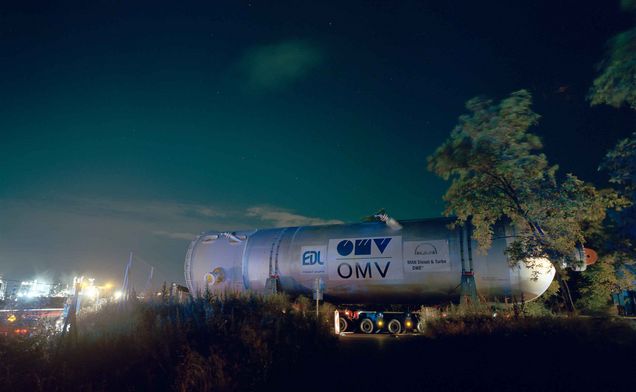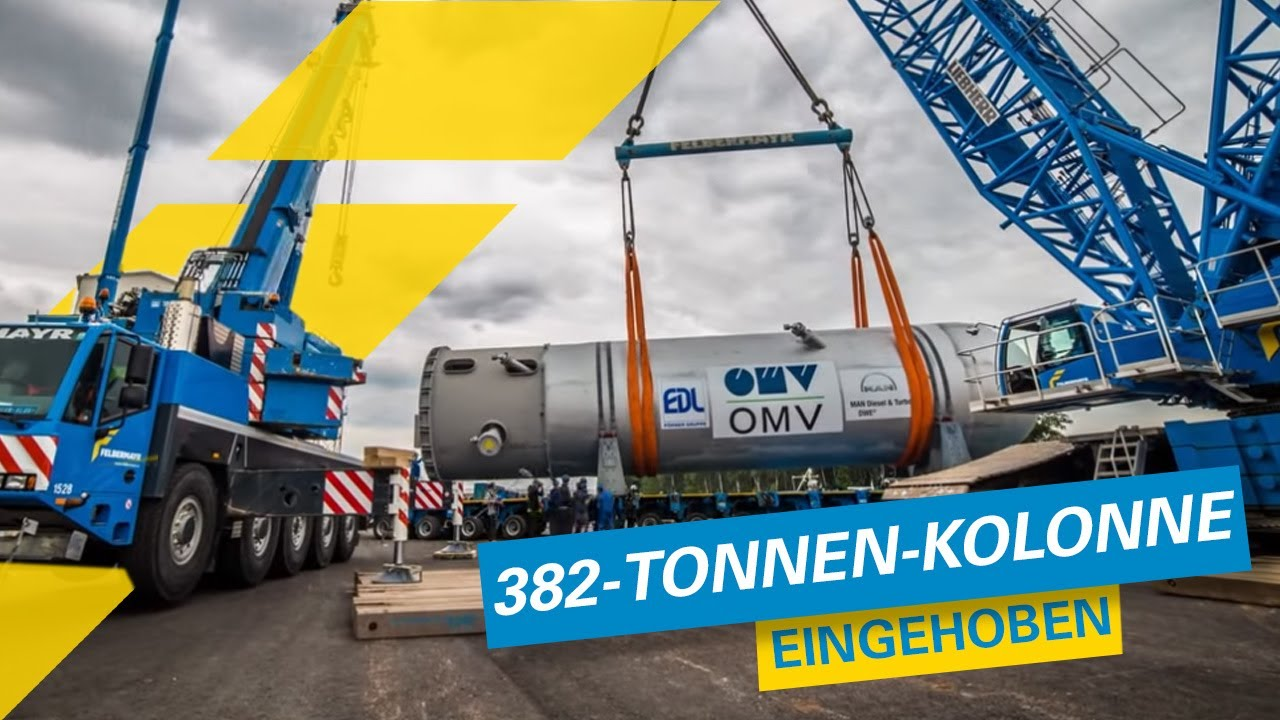382-ton column lifted with towerlift
June 19, 2015 | Markus Lackner
"What we did there is not something you do every day," said Günther Wimmer from Felbermayr Transport and Lifting Technology as he opened the discussion about the project, which was essentially conceived by Felbermayr Managing Director Wolfgang Schellerer. Roughly five terrabytes of data had amassed during the development phase, which took more than two and a half years. However, after the column had arrived at the Felbermayr transshipping area in Albern harbour and everything was primed for the lift from the ship onto the low-loader, that was thought to be the end of the job. At least in theory. It would only be known later if everything was to actually work as planned in the detailed computer studies.
A first in Albern harbour
More than 40 trucks were required to bring the LR1600 to the operating site in Albern harbour. With a charge weight of around 780 tons, the high-tech machine has a 600-ton load capacity. That is roughly the same weight as 500 medium-sized cars. "During unloading of the 382-ton column, the 42 metre-long main boom achieved a radius of 16 metres," explained Wimmer. It then reversed six metres with a suspended load, and subsequently swung roughly 65 degrees to the left, in order to finally place the load on the low-loader. It all seemed to happen in slow-motion. A 180 m² driving surface was designed with pieces of red ironwood to ensure the best possible weight distribution. The mass was distributed suitably on it, with the weight of the crane and column being optimally channelled into the ground below. After just over an hour, the lift was complete and the load was placed on to an 18-axle low-loader. Now the load could begin to be secured for the journey that lay ahead.
Technology overcomes bridge statics
It all got under way on the evening of 20th June. 1300 horsepower was quietly ticking over on the way there. Everything was prepared for the first stage. "This led us from the transshipping and storage site in Albern harbour to the site of the OMV refinery, which was roughly seven kilometres away. Two Mercedes Actros with three-axle drive were used as tractor and shunting units. To achieve the required traction, each machine was ballasted to 35 tons," explains Wimmer. Altogether, with the low-loader and the column, a total transport weight of roughly 570 tons was achieved. After a journey of two kilometres lasting approximately an hour, the convoy reached Schwechat bridge. Since the load-bearing capacity of the bridge was not up to the statistical requirements of the load being transported, special measures had to be implemented. Wimmer explains: "To this end, counter pressure was built up using a special steel structure underneath the bridge. Using sensors with particularly advanced technology, the counter pressure was continuously adjusted to the current load and achieved levels of 50 to 200 bar. The bridge was also monitored during the crossing using a bridge monitoring system to document possible consequential damage." This technology makes it possible to record theoretically possible damage to bridges caused by vibration behaviour. It means the condition of the bridge after the crossing can be compared with that from before.
Further key parts of the journey to the OMV were the eastern thoroughfare in Mannswörth and the slip road on to the A4. Wimmer stated that cars continually parking along streets create uncertainty during heavy transport. Flyers were distributed in advance to avoid this. Wimmer also added, however, that the public were always very understanding and adhered to the required stop and parking instructions. At roughly 1am, the heavy transport drove onto the A4 using a temporary ramp, crossed the motorway and then proceeded to drive approximately a kilometre on the other side of the road in the direction of the Danube bridge. At this point, the heavy transport, which totalled 52 metres in length, left the motorway once more and reached the site of the OMV works approaching 2am.
Power with the Towerlift
Inadequate static conditions and a pipeline bridge made the task even harder for the 38-strong transport team. Shortly after entering the plant, a pipeline bridge was encountered that could not be driven under. "In order for the approximately seven metre-high transport to still get through, a slide system was created by our Heavy Equipment department. Using this made it possible to unload the column from the low-loader and slide it under the pipeline bridge," explained Wimmer. Once on the other side, the steel giant was placed on a 16-axle self-propelled transporter and driven to the actual destination.
Due to the conditions of the ground and the limited working space, the load could not be lifted using a crane, so a tipper provided the big finale instead. "Our colleagues from Heavy Equipment in Krefeld achieved something brilliant," said Wimmer. This was because a 36 metre-high Towerlift was required to turn the column using the tipper. As part of a week-long process, some 160 tons of steel were used. The tipper was mounted to the bottom end of the container for the final positioning of the base. The Towerlift's strands were attached to the top end. Using lifters, the strands were pulled upwards and the SPMT followed steadily, while the container was brought vertically over the tipper. "This process took roughly five hours," noted Wimmer. The tipper was then detached from the SPMT and the column was lifted up. It took roughly five hours until the reactor moved around eight metres to the side using the rail-mounted Towerlift, turned 36 degrees and could be set on the base. With that, the process was successfully brought to a close with a technically demanding finale.
The high-tech steel giant will subsequently be incorporated into the refinery's desulphurisation facility by the customer, OMV, in order to replace an existing container from the 1980s.












